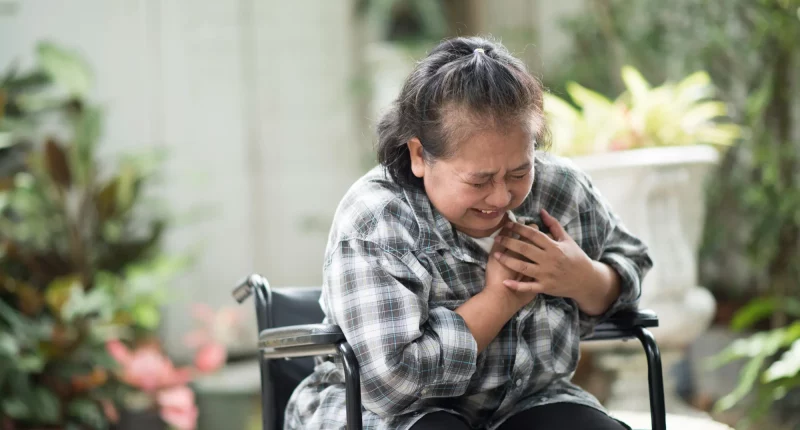Takotsubo cardiomyopathy, also called broken heart syndrome, is a heart condition triggered by sudden stress. It’s not a cardiac arrest, but it shows similar signs, like chest pain and shortness of breath. Unlike heart attacks, which are usually due to blocked arteries, takotsubo cardiomyopathy does not involve primary heart disease. However, it still requires hospital medication.
Healthcare providers may refer to this condition as apical ballooning syndrome or stress cardiomyopathy. It primarily affects the left ventricle, the heart’s main pumping chamber. In medical scans, the left ventricle often looks like it is ballooning out.
The chance of death from takotsubo cardiomyopathy is similar to that of a heart attack, but with proper treatment, most individuals recover fully. This condition is most common in women between the ages of 62 and 76. Men can also get it, but they tend to have a less favorable outlook.
Takotsubo cardiomyopathy usually occurs after a person experiences intense emotional or physical stress, such as the death of a loved one or a severe illness. Despite its dramatic onset, with appropriate care, many people make a good recovery.
Causes
The exact cause of takotsubo cardiomyopathy remains unclear. However, scientists believe that extreme stress triggers the unlocking of stress-linked hormones, like epinephrine, which can lead to disrupt heart function and blood vessel spasms. This disruption leads to the malfunction of the ventricles, causing the left ventricle to balloon out. When this happens, the heart muscle struggles to pump blood effectively. Even though this condition often settles on its own, extended ventricle ballooning can lead to serious issues, including congestive heart failure, which occurs in almost 20% of cases.
Takotsubo cardiomyopathy is mainly more frequent in Women than in men, prompting scientists to explore the role of hormones like estrogen. They suspect that low estrogen levels may contribute to the condition.
Risk Factors
The risk factors for takotsubo cardiomyopathy are largely environmental, indicating a complex interplay between external factors and biological influences, like hormone levels. Interestingly, the same stressful event may not trigger symptoms every time, suggesting variability in individual responses.
Several environmental factors can increase the risk of developing takotsubo cardiomyopathy. These include highly stressful or traumatic events such as domestic violence, the death of a loved one, accidents, natural disasters, financial losses that happen majorly, and arguments. Additionally, a recent determination of a serious illness or the use of drugs like cocaine or amphetamines can also be risk factors. In some cases, even positive events like winning the lotteries or a surprise party have been known to trigger the condition. This wide range of triggers underscores the unpredictable nature of takotsubo cardiomyopathy and its strong link to emotional and physical stressors.
Symptoms
Takotsubo cardiomyopathy symptoms are closely the same as a heart attack. Common symptoms include an irregular heartbeat, fainting or dizziness, breath shortness, and chest pain. In some cases, people may also experience stroke-like symptoms, such as numbness, confusion on half of the body, or facial weakness.
Given the overlap in symptoms, it is impossible to determine takotsubo cardiomyopathy depending on symptoms. Anyone experiencing chest pain should treat it as a medical emergency and seek immediate help to ensure proper diagnosis and treatment.
Diagnosis
To diagnose takotsubo cardiomyopathy, healthcare providers use a similar approach to determining a heart attack. They may recommend several tests, including:
- EKG: This test views the electrical activity.
- Blood Tests: These check for enzymes connected with heart attacks.
- Angiogram: This test visualizes the heart’s blood vessels.
- Echocardiogram: This imaging test provides a picture of the heart.
- MRI Scan: This gives a detailed heart image.
A diagnosis of takotsubo cardiomyopathy is based on specific criteria. Healthcare providers look for a recent stressful situation, the absence of obstructive coronary disease or evidence of recent plaque rupture, EKG abnormalities, a slight raised in the chemical troponin, no symptoms of myocarditis (inflammation of the heart), and the characteristic ballooning of the left ventricle.
Treatment
People with takotsubo cardiomyopathy require supportive care until their left ventricle, the heart’s main pumping chamber, recovers. This usually requires a hospital stay of many days, with full recovery often taking 21 to 28 days or longer.
Healthcare providers commonly prescribe medications to aid in recovery. These include:
- Beta-Blockers: These help reduce the heart’s workload and control heart rate.
- ACE Inhibitors: These help the heart muscle recover and prevent further damage.
In some cases, healthcare providers may suggest blood-thinning medicines to prevent strokes, particularly if the patient has a heart arrhythmia or has a chance of getting one.
For ongoing care, patients might be required to take beta-blockers or anti-anxiety medications for a prolonged period. These medications help control the unlock of stress hormones, which can be a trigger for the condition. Managing and decreasing stress is also crucial in preventing recurrence. This can involve lifestyle changes, stress management techniques, and possibly therapy to address any underlying issues contributing to the stress.
Complications
While takotsubo cardiomyopathy is generally a non-cancerous condition, it does increase the chance of getting other health issues. These complications include blood clots, heart failure, serious heart arrhythmias, heart valve issues, and cardiogenic shock. Because of these risks, close follow-up care with a heart specialist is essential to observe heart health.
Healthcare providers are still uncertain about the long-term effects of takotsubo cardiomyopathy. They are aware that this syndrome is not caused by existing heart disease. Rather, it is believed that stress triggers serious issues in the heart, leading to blood vessel damage and inflammation, which causes short-term left ventricle ballooning.
Most individuals recover fully from takotsubo cardiomyopathy, even without medication. However, some individuals may experience heart damage, with up to twenty percent getting congestive heart failure.
Prevention
Healthcare providers are not entirely sure why stressful events cause takotsubo cardiomyopathy in some individuals and not in others. They also don’t know why few individuals develop the condition even without experiencing a stressful event. Because of these uncertainties, there are no guaranteed ways to prevent it.
However, managing stress better can be helpful. This might include finding healthy ways to cope with stress, seeking support from family and friends, and possibly working with a therapist. These steps can help reduce the risk, even though they cannot completely prevent the syndrome.
Summary
Takotsubo cardiomyopathy, or broken heart syndrome, is a stress-induced heart condition that mimics a heart attack but is not caused by underlying heart disease. Symptoms include chest pain, shortness of breath, and irregular heartbeat. Diagnosis involves tests like EKGs, blood tests, and imaging scans.
Treatment typically includes medications like beta-blockers and ACE inhibitors, with a focus on stress management. While most people recover fully, the condition can lead to complications such as heart failure and severe arrhythmias. Preventing the syndrome is challenging, but better stress management may help reduce the risk.









